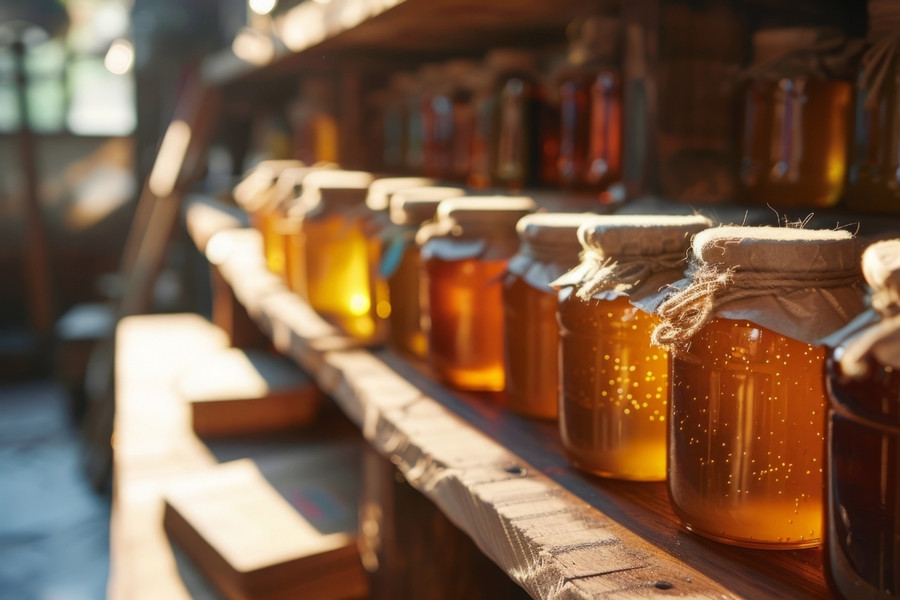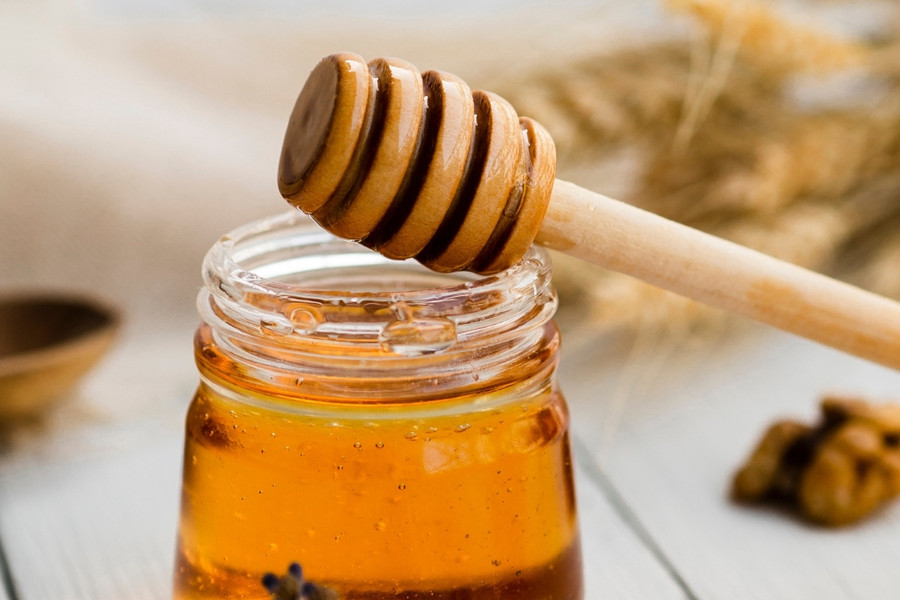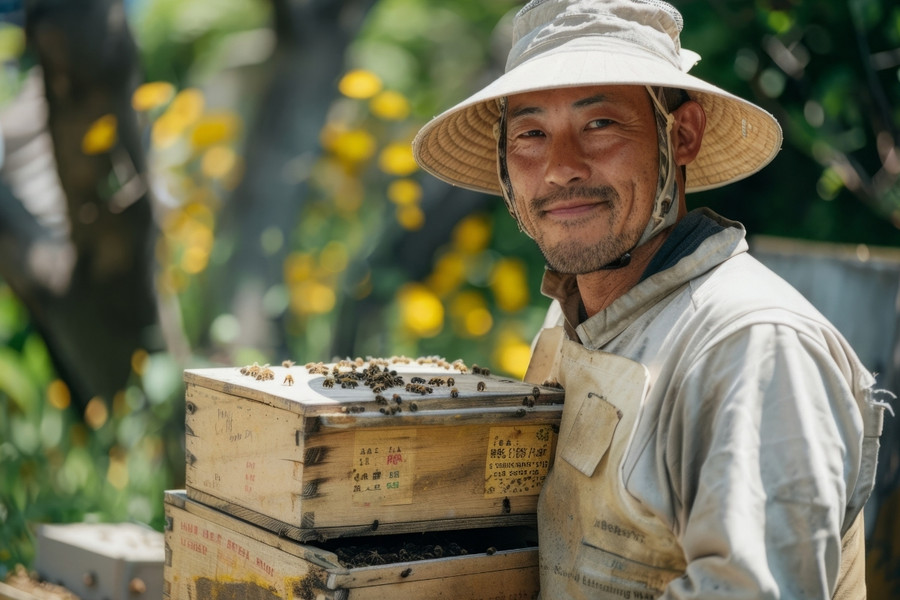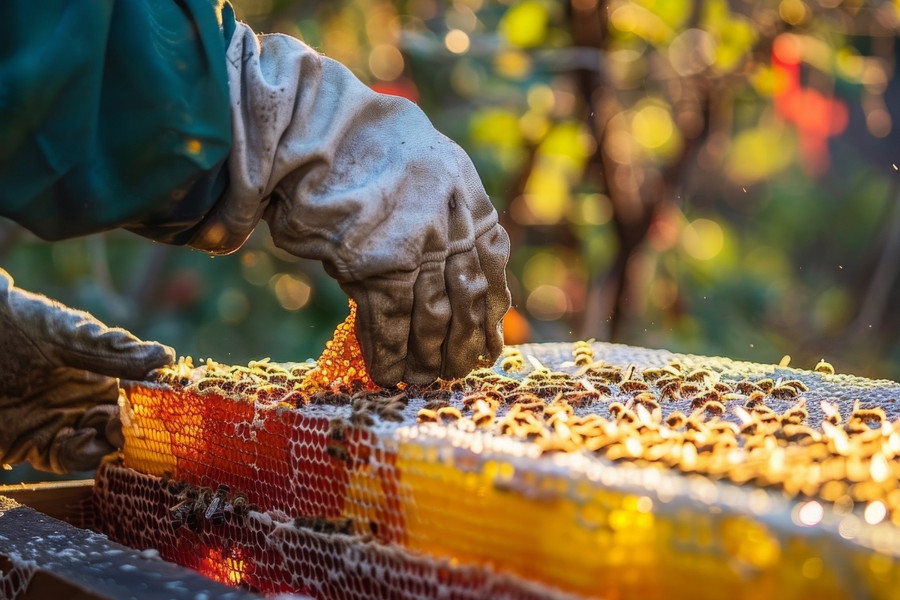In the verdant hills of Darjeeling, where altitude meets artistry and tradition blends with innovation, three distinct types of honey tell the story of this remarkable region’s biodiversity. Each variety—Forest Honey, Multi-Floral Honey, and the prestigious Tea Honey—offers a unique window into the complex ecosystem that makes Darjeeling a world-renowned destination for both tea and honey connoisseurs.
The Darjeeling Advantage: Why Location Matters
Before diving into the specifics of each honey variety, it’s essential to understand what makes Darjeeling honey exceptional. Nestled at altitudes ranging from 2,000 to 7,000 feet above sea level, the Darjeeling region enjoys a unique microclimate that creates ideal conditions for both diverse flora and exceptional honey production.
The Terroir Effect
Just as Darjeeling tea carries the distinct characteristics of its terroir, Darjeeling honey reflects the region’s:
- Pristine Environment: Clean mountain air and minimal industrial pollution
- Diverse Ecosystems: From dense forests to cultivated gardens to wild meadows
- Seasonal Variations: Distinct flowering periods that create unique honey profiles
- Altitude Influence: Higher elevations contribute to slower nectar maturation and concentrated flavors
Forest Honey: The Wild Symphony
Origin Story
Deep within Darjeeling’s ancient forests, where sunlight filters through canopies of oak, rhododendron, and indigenous flowering trees, bees embark on foraging expeditions that span centuries-old ecosystems. Forest Honey represents the untamed essence of Darjeeling’s wilderness—a liquid chronicle of biodiversity that cannot be replicated or controlled.
Flavor Profile: Complex and Robust
Primary Notes:
- Rich, Dark Amber Color: Deep golden hues that hint at its complex origins
- Robust Intensity: Bold, full-bodied flavor that commands attention
- Earthy Undertones: Subtle hints of forest floor, moss, and ancient wood
- Floral Complexity: Wild rhododendron, forest jasmine, and seasonal wildflowers
- Lingering Finish: Long-lasting aftertaste with hints of caramel and dried fruits
Seasonal Variations:
- Spring Forest Honey: Lighter, with prominent rhododendron notes
- Monsoon Forest Honey: Deeper, with intensified earthy characteristics
- Post-Monsoon Forest Honey: Balanced complexity with dried fruit undertones
Unique Characteristics
Crystallization Pattern: Forest Honey tends to crystallize more slowly due to its complex sugar composition, maintaining a smooth, creamy texture.
Medicinal Properties: Traditional knowledge attributes enhanced antimicrobial and antioxidant properties to Forest Honey due to the diverse plant compounds it contains.
Rarity Factor: Limited availability makes Forest Honey particularly precious, as production depends entirely on natural forest flowering cycles.
Multi-Floral Honey: The Garden’s Symphony
Origin Story
Multi-Floral Honey captures the essence of Darjeeling’s cultivated landscapes—kitchen gardens, agricultural fields, orchards, and the spaces where human cultivation meets natural wilderness. This honey tells the story of a region where traditional farming practices coexist harmoniously with wild ecosystems.
Flavor Profile: Balanced and Versatile
Primary Notes:
- Golden Amber Color: Classic honey appearance with warm, inviting tones
- Balanced Sweetness: Harmonious flavor that’s neither too mild nor overwhelming
- Floral Bouquet: Blend of mustard flowers, fruit blossoms, herb flowers, and wildflowers
- Fresh Finish: Clean, pleasant aftertaste with subtle floral lingering
- Seasonal Dynamics: Changes character based on predominant blooming seasons
Flavor Journey Throughout the Year:
- Spring Character: Apple and pear blossom notes with fresh grass undertones
- Summer Profile: Mustard flower dominance with herb garden complexity
- Autumn Essence: Orange and citrus blossom with late-season wildflower notes
Unique Characteristics
Versatility Champion: Multi-Floral Honey’s balanced profile makes it incredibly versatile for both culinary applications and direct consumption.
Consistency: More predictable flavor profile compared to Forest Honey, making it ideal for regular consumption and cooking.
Accessibility: Generally more available than specialized varieties, representing the “everyday luxury” of Darjeeling honey.
Tea Honey: The Signature Masterpiece
Origin Story
Tea Honey represents the pinnacle of Darjeeling’s honey artistry—a product that could only exist in this specific region where the world’s finest tea gardens provide bees with access to Camellia sinensis flowers. This is not just honey; it’s liquid terroir that captures the essence of Darjeeling’s tea heritage.
Flavor Profile: Sophisticated and Unique
Primary Notes:
- Pale Golden Color: Delicate, almost champagne-like hue that reflects its refined origins
- Subtle Tea Essence: Distinctive muscatel notes that mirror Darjeeling tea characteristics
- Floral Elegance: Delicate tea flower sweetness with sophisticated complexity
- Smooth Texture: Silky consistency that coats the palate gently
- Refined Finish: Clean, sophisticated aftertaste with lingering tea garden notes
The Darjeeling Signature: Tea Honey carries the famous “muscatel” flavor that makes Darjeeling tea legendary worldwide, creating a unique bridge between two of the region’s most celebrated products.
Unique Characteristics
Exclusivity: Only possible in regions where tea plants flower and bees have access to these specific blossoms.
Seasonal Rarity: Tea plants don’t flower year-round, making Tea Honey extremely limited and precious.
Culinary Prestige: Considered a gourmet ingredient by chefs and food enthusiasts worldwide.
Comparative Analysis: Side by Side
Visual Comparison
| Characteristic | Forest Honey | Multi-Floral Honey | Tea Honey |
|---|---|---|---|
| Color | Dark amber to deep golden | Golden amber | Pale golden, champagne-like |
| Consistency | Thick, slow-flowing | Medium consistency | Smooth, silky |
| Crystallization | Slow, creamy | Moderate, fine crystals | Very slow, maintains fluidity |
| Clarity | Slightly cloudy (natural) | Clear to slightly cloudy | Crystal clear |
Flavor Intensity Scale
Forest Honey: ★★★★★ (Bold and Complex) Multi-Floral Honey: ★★★☆☆ (Balanced and Approachable) Tea Honey: ★★★★☆ (Refined and Sophisticated)
Rarity and AvailabilityForest Honey: Limited seasonal availability, depends on forest flowering cycles. Multi-Floral Honey: Most consistently available throughout the year
Tea Honey: Extremely limited, seasonal production only
Perfect Pairings and Culinary Applications
Forest Honey Applications
Best Used For:
- Cheese Platters: Pairs exceptionally with strong, aged cheeses
- Dark Breads: Complements rye, pumpernickel, and sourdough
- Grilled Meats: Excellent as a glaze for lamb, beef, or game
- Winter Beverages: Hot toddies, mulled wine, and herbal teas
- Dessert Drizzling: Over dark chocolate desserts and fruit tarts
Flavor Partnerships: Works beautifully with nuts, dried fruits, strong spices, and robust wines.
Multi-Floral Honey Applications
Best Used For:
- Daily Tea and Coffee: Perfect everyday sweetener
- Baking: Ideal for cakes, cookies, and bread recipes
- Breakfast Foods: Pancakes, waffles, oatmeal, and yogurt
- Salad Dressings: Honey-mustard and vinaigrette bases
- Marinades: Versatile base for meat and vegetable marinades
Flavor Partnerships: Complements fresh fruits, mild cheeses, herbs, and light wines.
Tea Honey Applications
Best Used For:
- Premium Tea Service: Enhancing fine Darjeeling and Earl Grey teas
- Gourmet Desserts: Sophisticated pastries and confections
- Artisanal Cocktails: Premium honey cocktails and mocktails
- Gift Presentations: Luxury gift baskets and special occasions
- Culinary Artistry: High-end restaurant applications
Flavor Partnerships: Pairs beautifully with delicate pastries, light teas, champagne, and subtle spices.
Health Benefits Spectrum
Forest Honey: The Wellness Powerhouse
- Highest Antioxidant Content: Diverse plant sources contribute to maximum antioxidant variety
- Natural Antibiotics: Wild plant compounds enhance antimicrobial properties
- Seasonal Immunity: Different flowering periods provide varied immune support
- Traditional Medicine: Long history of use in folk remedies
Multi-Floral Honey: The Balanced Healer
- Consistent Nutrition: Reliable source of vitamins, minerals, and enzymes
- Digestive Support: Gentle on the stomach, suitable for daily consumption
- Energy Source: Balanced sugar profile provides sustained energy
- Allergy Relief: Local pollen exposure may help with seasonal allergies
Tea Honey: The Refined Remedy
- Tea Plant Benefits: Inherits some polyphenol properties from tea flowers
- Gentle Energy: Provides energy without overwhelming the palate
- Digestive Harmony: Particularly gentle, suitable for sensitive constitutions
- Antioxidant Elegance: Refined antioxidant profile from tea plant sources
The Production Journey: From Hive to Jar
Harvesting Differences
Forest Honey Collection:
- Seasonal harvesting aligned with forest flowering cycles
- Careful location selection to access diverse forest flowers
- Minimal human intervention to preserve wild characteristics
- Weather-dependent collection schedules
Multi-Floral Honey Collection:
- More predictable harvesting schedule
- Strategic hive placement near diverse agricultural areas
- Seasonal adjustments based on predominant flowering crops
- Consistent production volumes
Tea Honey Collection:
- Extremely precise timing during tea flowering periods
- Exclusive access to tea garden flowers
- Limited collection windows (typically 2-3 times per year)
- Careful separation from other honey types
Processing Excellence
All three varieties follow IVY Cooperative’s commitment to:
- Minimal Processing: Preserving natural enzymes and beneficial compounds
- Quality Testing: Rigorous purity and quality standards
- Hygienic Bottling: Modern facilities maintaining traditional quality
- Traceability: Complete documentation from hive to consumer
Pricing and Value Proposition
Understanding the Price Spectrum
The pricing of Darjeeling honey reflects rarity, production complexity, and unique characteristics:
Multi-Floral Honey (₹399/300g):
- Excellent value for premium daily-use honey
- Consistent availability and reliable quality
- Perfect introduction to Darjeeling honey
Forest Honey (₹399/300g):
- Exceptional value for wild, complex honey
- Limited availability adds to its desirability
- Premium experience at accessible pricing
Tea Honey (₹999/300g):
- Luxury pricing reflecting extreme rarity
- Unique product available nowhere else
- Investment in culinary and cultural experience
Value Beyond Price
Each honey variety offers value that extends beyond monetary considerations:
- Supporting Sustainable Practices: Every purchase supports eco-friendly beekeeping
- Community Empowerment: Directly benefits local beekeepers and their families
- Cultural Preservation: Helps maintain traditional beekeeping knowledge
- Environmental Protection: Encourages biodiversity conservation
Choosing Your Perfect Honey
For the Adventurous Palate
Choose Forest Honey if you:
- Enjoy bold, complex flavors
- Appreciate wild, untamed food experiences
- Want maximum antioxidant benefits
- Love pairing honey with strong foods and wines
For the Practical Gourmet
Choose Multi-Floral Honey if you:
- Want versatile, everyday luxury
- Prefer balanced, approachable flavors
- Need reliable availability for regular use
- Enjoy baking and cooking with honey
For the Connoisseur
Choose Tea Honey if you:
- Seek unique, exclusive experiences
- Appreciate subtle, sophisticated flavors
- Want to gift something truly special
- Enjoy connecting with Darjeeling’s tea heritage
Storage and Serving Recommendations
Optimal Storage Conditions
All Varieties:
- Store in cool, dry places away from direct sunlight
- Use airtight containers to prevent moisture absorption
- Avoid refrigeration (can accelerate crystallization)
- Keep away from strong odors
Serving Suggestions
Temperature Matters:
- Serve at room temperature for optimal flavor release
- Gently warm crystallized honey in a water bath
- Never microwave honey (destroys beneficial enzymes)
Serving Quantities:
- Tasting: 1/4 teaspoon to appreciate pure flavor
- Tea Sweetening: 1/2 to 1 teaspoon depending on preference
- Cooking: Follow recipe guidelines, typically 1:1 ratio with sugar
The Future of Darjeeling Honey
The honey spectrum of Darjeeling—Forest, Multi-Floral, and Tea—represents more than just different flavors; it’s a testament to the region’s incredible biodiversity and the skilled artisans who work in harmony with nature to create these liquid treasures.
Whether you’re drawn to the wild complexity of Forest Honey, the balanced versatility of Multi-Floral Honey, or the sophisticated rarity of Tea Honey, each variety offers a unique journey through Darjeeling’s remarkable landscape. They remind us that the best things in life come from patience, respect for nature, and the wisdom passed down through generations.
In choosing any of these honeys, you’re not just selecting a sweetener—you’re supporting sustainable agriculture, empowering local communities, and becoming part of a story that connects the ancient forests and tea gardens of Darjeeling to tables around the world.
The choice is yours, but the journey is always sweet.
Ready to explore Darjeeling’s honey spectrum? Visit www.darjeelinghoney.com to order your selection and experience the unique character of each variety.
Multi-Floral Honey (300g) – ₹399
Forest Honey (300g) – ₹399
Tea Honey (300g) – ₹999
Each jar represents the dedication of over 100 trained beekeepers across nine villages and four tea gardens in the Darjeeling region, working under the banner of IVY Multipurpose Cooperative Society’s mission: “Together for a better tomorrow.”




